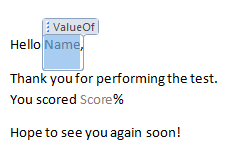Request a trial-version now and see for yourself!
Contact us at [email protected].
Request a trial-version now and see for yourself!
Contact us at [email protected].
Template-based document generation means that the target document is not created from scratch, but a template is used as a starting point. The template specifies the design of the document and contains special placeholders that indicate where data much be placed. The generation proces loads the template and merges the data, which results in the final document. Optionally the generated document can be password-protected (encrypted).

Because the template is our starting point, the document can be completely designed using just Word. No need for programming against a complex API's.
No compromises, just beautiful documents!
Templates are basically just regular Word-documents. Therefore they can be created by using the most popular document processor around: Microsoft Word ®!
The Docati Word-AddIn is an add-in/plug-in for Microsoft Word®. It adds a special ribbon (toolbar) which grants access to all Docati-functionality a template designer needs:

Inside the text of the template, special placeholders must be placed, to let the Docati Document Generator know where to insert the data. The Docati Word Add-In is required to insert these placeholders. This is an example of a template containing placeholders:

Available placeholders are:
Data can be supplied as either XML or Json. Placeholders must specify a query to refer to specific parts of the data. Queries can be specified in two formats:
In most cases, regular queries will do the job. For example, take this data-XML:

Say you need the name of the examinee. Using a regular query you would simply specify Name and Docati will find it.
Check the documentation for more information on queries.